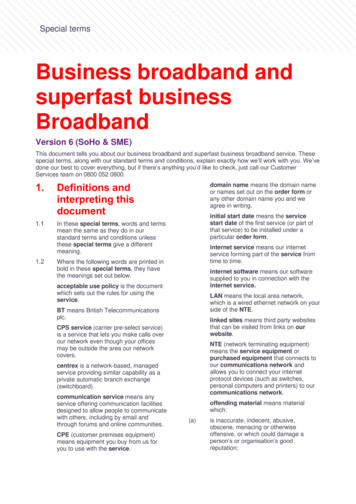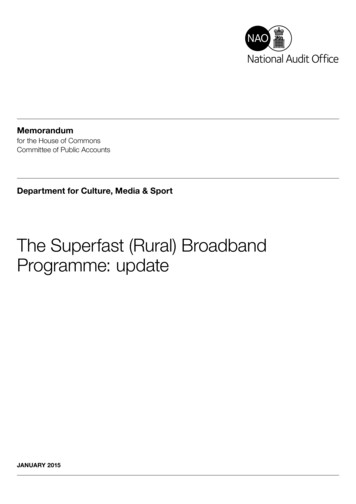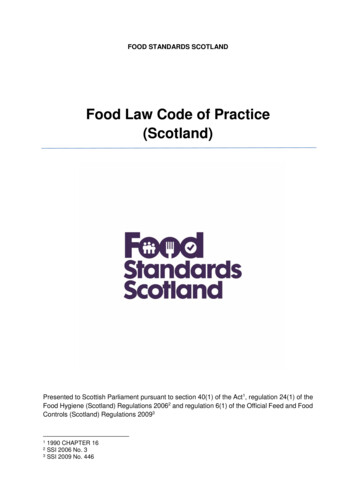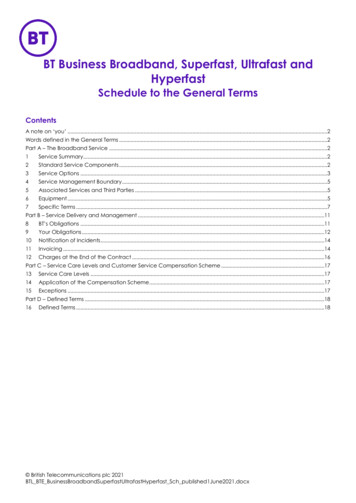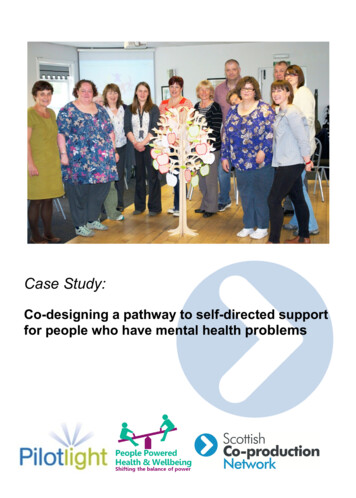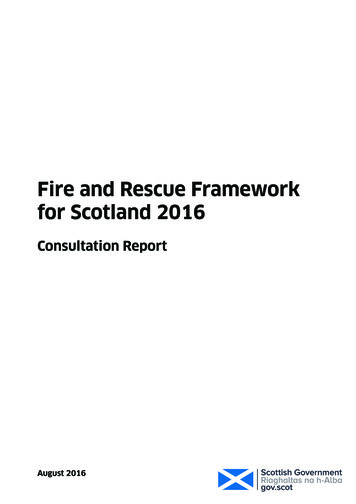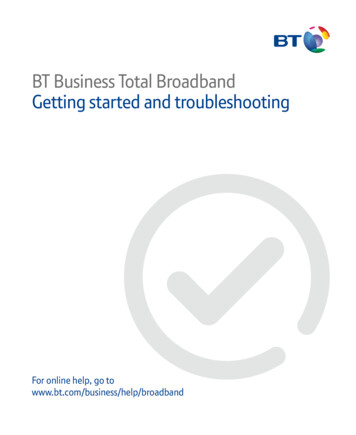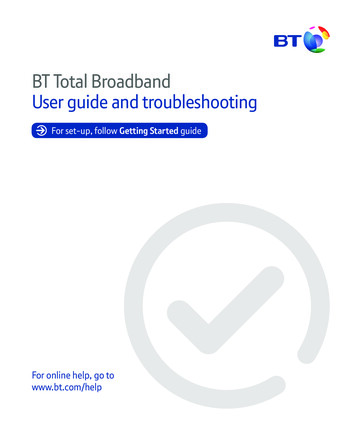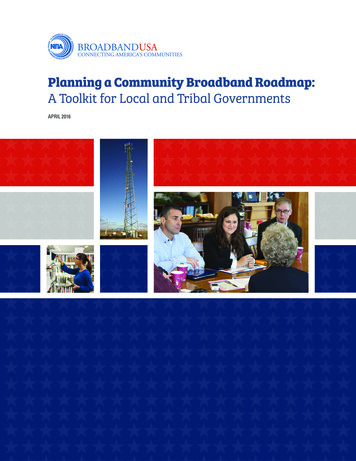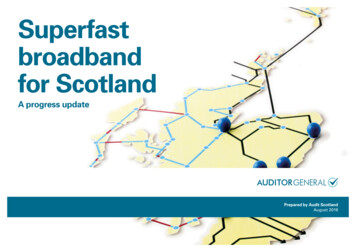
Transcription
Superfastbroadbandfor ScotlandSuperfast broadband for Scotland: A progress update 1A progress updatePrepared by Audit ScotlandAugust 2016
Superfast broadband for Scotland: A progress update 2Auditor General for ScotlandThe Auditor General’s role is to: appoint auditors to Scotland’s central government and NHS bodies examine how public bodies spend public money help them to manage their finances to the highest standards check whether they achieve value for money.The Auditor General is independent and reports to the Scottish Parliamenton the performance of: directorates of the Scottish Government government agencies, eg the Scottish Prison Service,Historic Environment Scotland NHS bodies further education colleges Scottish Water NDPBs and others, eg Scottish Police Authority, Scottish Fire andRescue Service.You can find out more about the work of the Auditor General on our website:www.audit-scotland.gov.uk/about/agsAudit Scotland is a statutory body set up in April 2000 under the PublicFinance and Accountability (Scotland) Act 2000. We help the Auditor Generalfor Scotland and the Accounts Commission check that organisationsspending public money use it properly, efficiently and effectively.
Superfast broadband for Scotland: A progress update 3Key factsAbout the contracts to deliver superfast broadband in ScotlandWhy is the public sector investingin superfast broadband?The Scottish Government aims to extendaccess to the fibre network in areas whicharen’t reached by the market alone, suchas rural and remote communities andbusinesses. It anticipates that improvedconnectivity will stimulate business innovation,boost productivity and enhance Scotland’sinternational competitiveness.What will the contracts deliver? 24Mb/smillionA total investment of 412 million: 146 million for the Highlands and Islands,which covers the three island councils, Highlandand Moray Councils and parts of North Ayrshireand Argyll and Bute; and 266 million for therest of Scotland.The Scottish public sector as a whole isexpected to contribute funding of 165 million. The balance will be provided bythe UK Government, the EU and BT.What do the projects involve?BT is looking to get the fibre network asclose as technically possible to homes andbusinesses. Existing copper cabling will usuallymake the final connection to the home. In someareas, fibre cabling will be used the entire lengthalthough this is a more expensive option. 85 per cent of premises by March 2016 95 per cent of premises by December 2017.BT stated in the contracts that it expects77 per cent of premises to achieve speedsof more than 24 Mb/s. But due to the lengthof copper cabling and other geographic andtechnical reasons, the Scottish Government,Highlands and Islands Enterprise (HIE) and BTcannot guarantee the actual speeds premiseswill receive.How much will the contracts cost? 412The contracts with BT are expected to deliveraccess to a broadband network to:What’s next?2020The Scottish Government has a visionfor Scotland to have world-class digitalinfrastructure by 2020 to enable anyone inScotland to communicate and connect instantlyusing any device, anywhere, anytime. To dothis, it needs to enhance broadband coveragebeyond that provided by the contracts. In May2016, Scottish ministers committed to deliver100 per cent superfast coverage by 2021.2015Exhibit 1:How superfast broadbandreaches users10 Exhibit 1How superfast broadband reaches usersBT is replacing parts of the copper network with fibre to the premise and fibre to the cabinet. However, in veryremote areas BT may need to use alternative technology (such as satellite) to provide basic broadband binetSatelliteCoppernetworkFibre to the cabinet(FTTC)Fibre to thepremise (FTTP)2 Mb/sUp to 24 Mb/sUp to 80 Mb/sUp to 330 Mb/sInternet provided through Broadband provided through Fibre optic cables from the Fibre optic cable all thesatellite technology for the the existing telephoneexchange to cabinet andway to the premise.most remote areas, butnetwork. Speed variesthen existing copper linesnot at superfast speeds.depending on technologyto the home.available in cabinets.Cheaper option forremote areas than fibreas little or no engineeringwork is needed.In some areas technologyis able to provide goodspeeds. Uses the existingnetwork so limitedadditional cost.Some of the benefits offibre optics but at lesscost. It relies on existingnetwork for connection tothe home.Very fast speeds suitablefor multiple users anddoing a number of thingsat once on the Internet.Speeds reduce withmultiple users andpoor weather. Satelliteconnections have a delaywhich causes problemsfor gaming and Skype.Copper lines lose speedSpeeds reliant on theMost expensive optionquickly with distance from distance and quality of the as it requires morethe exchange, long linescopper connection.engineering work toare significantly slower thanlay cables.24 Mb/s. The number ofpeople online, poor weatherand the condition of thecopper all reduce speeds.Note: In some instances pre-existing local exchanges will not be used. Instead FTTC and FTTP will connect to the networkthrough handover points.Source: Audit Scotland
Superfast broadband for Scotland: A progress update 4Key messages12The Scottish Government and HIE have appointedBT to extend the existing fibre broadband networkin Scotland. The contracts are intended to make amajor contribution towards achieving the ScottishGovernment’s vision for a world-class infrastructurewhich would allow people to connect to the Internetanywhere, anytime, and on any device by 2020.Targets to provide access to fibre broadband to 85 percent of premises by March 2016 have been achieved.The contracts are currently on track to provideaccess to 95 per cent of premises by December 2017,although the remainder of the roll-out will be morechallenging.So far, more premises connected to the network aremodelled to receive speeds which exceed 24 Mb/sthan is set out in the contracts. Across both contractsand areas provided through commercial coverage,the actual speeds that users receive will vary. Overall,premises in rural councils currently receive loweraverage speeds. The Scottish Government and HIEpaid BT 156 million for work done up to March 2016.Lower than expected costs and higher than expectedtake-up has contributed to 23 million more beingavailable to extend broadband coverage.3There is still much work to be done if the ScottishGovernment is to achieve its ambitious vision forScotland to have world-class digital infrastructureby 2020. It needs to finalise plans to best use anadditional 42 million available to extend broadbandcoverage and the future role of Community BroadbandScotland (CBS) in this. It also needs to define clearlywhat world class means and set out plans for howit will be achieved. In May 2016, it announced a newtarget of universal coverage of superfast broadbandinfrastructure across Scotland by 2021.4More could be done to address the recommendationsin our previous report on the roll-out of broadband.Specifically, there is scope to enhance public reportingof performance information to help assess the successof the investment, including speeds and level of takeup achieved.
Superfast broadband for Scotland: A progress update 5IntroductionAccess to reliable and fast broadband is increasingly essentialfor everyday lifeThe Scottish Government set out its policy ambition, in January2012, to deliver world-class digital access to all of Scotland by2020. The interim milestone was a significant uplift in speedsfor everyone by 2015, with speeds of 40-80 Mb/s for between85 to 90 per cent of premises.In 2013, the Scottish Government and HIE separatelycontracted BT to help deliver the Scottish Government’s aimby extending the existing fibre network across the country.Alongside commercial coverage, the contracts are intended toprovide access to fibre broadband to 85 per cent of premisesby March 2016, and 95 per cent of premises by December2017. BT expects at least 77 per cent of premises with accessto the network to achieve speeds of more than 24 Mb/s.This update examines: what progress the two contracts have made to date inrolling out a superfast broadband network the Scottish Government’s plans for further investment insuperfast broadband2015Superfastbroadband for Scotland:A progress reportFebruary 2015Superfastbroadband forScotland how the Scottish Government and HIE have responded tothe recommendations in our original reportA progress reportOur report Superfast broadband for Scotland: A progressreportin February 2015 considered the progress of thetwo projects to date. We agreed with the Scottish Parliament’sPublic Audit Committee to monitor the programme until bothcontracts are completed in 2018.Prepared by Audit ScotlandFebruary 2015Links0Progress against 2015recommendationPDF downloadWeb link
Superfast broadband for Scotland: A progress update 6ProgressThe Scottish Government achieved its target to provide accessto fibre broadband to 85 per cent of premises by March 20162.2m premisesMarch out of 2.6m (86%)2016 have access tofibre broadband% premisesplanned(by Dec 2017)% premisesachieved(Mar 2016)500,000 premiseshave been providedwith access throughthe contracts6 council areas are still toachieve the contractual targetexpected %commercialcoverageThese are rural councils wherecommercial coverage is limited(by Dec 2017)10026 councilareas90exceed the target% of premises80706075%504070%302010MorAr Hig aygyhlallnOr and dknBuSh ey I tesetlan landdIsslEil andseanSiarWestDunbartonDNo un shiredrtheLa e CitynaAbrerd kshiee renCCitityyoFaSo f Ed lkirkuthinLa burgnark hClaInv shireckma erclydnnan eshireGEast lasg FifeDuowCEa nbarto itystRensnfr hireRe ewsnfr hirSo ew euth shA ireEa yrshstirNo Ayr erth shireAW yrshirestLeoM thianidEa lothiastLo nthiaSt nirlingDumf Abe Angrrieds a een usndsScG hirott allo ePe ish wayrth Boan rded K rsinross0Source: Rest of Scotland contract award recommendation report, HIE board papers and Scottish Government’s project monitoring filesContractualtargetEilean Siar targetDue to the area’sremoteness and terrain
Superfast broadband for Scotland: A progress update 7The projects are currently on track to provide access to95 per cent of premises by December 2017, althoughthe remainder of the roll-out will be more challengingCoverage to March 201695%coverageAssuming both projects continue tomeet their contractual targets, theScottish Government can expect toachieve its 95 per cent coverage targetby December 2017.So far, the roll-out has concentrated onthe easier to reach areas. The areas thatremain are more remote and likely to needmore complicated and costly engineeringsolutions. Project teams are monitoringwhat this means for the rest of the roll-out. 1,700150Commercial coverageAccess providedthrough the contractReproduced by permission of Ordnance Survey on behalf ofHMSO. Crown copyright and database right (2016).All rights reserved. Ordnance Survey Licence number 100024655.Postcode Boundaries: National Records of Scotland (2012).There is a cap of 1,700 on how muchBT can spend on each premise. Whenit costs more than 1,700 to make aconnection available, BT may be allowedto proceed depending on value-for-moneyconsiderations, including levels of existingcoverage and the availability of othertechnical options.So far, solutions have not beenfound for 150 premises, out of the4,600 premises which havebreached the cap (3.3 per cent).The contractual target isthe minimum number ofpremises that BT mustprovide with access to thenetwork each quarter to bepaid for the work it does.
Superfast broadband for Scotland: A progress update 8So far, more premises with access to the network aremodelled to receive speeds exceeding 24 Mb/s thanset out in the contracts1melled speeoddsBT’s contractualrequirement is tobuild infrastructurethat should deliver: 24Mb/s 77%March 2016, the ScottishGovernment reported:premises%87of premises withaccess through thecontracts shouldreceive modelledspeeds 24Mb/s 24 Mb/sHighlands& Islands13%23%SpeedsachievedSpeedsexpected(March 2016)(as per contracts)87%81%89%Rest ofScotlandSource: Speed coverage templates in both contracts and contract monitoring documentsThe infrastructure that BT is building will not provide speedsof 40-80 Mb/s to all premises. It will deliver these speeds tosome premises and improved speeds to others.The Digital Scotland websitegives details on whether apremise has access to fibre,and if not, its current status.If fibre access is plannedwithin the next six months,this will be specified.Timescales beyond sixmonths are not sharedpublicly as the ScottishGovernment and HIE arenot able to commit to these,until BT has completed itssurvey work.77%Unspecifiedor 24 Mb/sProgressagainst 2015Recommendation 1The Scottish Government, HIE and BT believe this can be builtupon in the future to deliver world-class infrastructure.The website also gives arange of speeds premisescan receive if they haveaccess to the fibre network.The DigitalScotlandwebsite:www.scotlandsuperfast.com
Superfast broadband for Scotland: A progress update 9The Scottish Government and HIE have paid BT 156 millionfor work completed by March 20164BT’s spend comparedto project plan 156millionHighlandsand Islands 5.5m less 76m 80mPaymentsto BTScottishGovernmentHIERest of Scotland 23m lessHighlands and IslandsBT is modelling how it can usethis money to extend coverage. 24.5mRest of arJunSept2016DecMarLess than planned( million) 0-5ScottishGovernmentThe Scottish Government’spayments to BT are now inline with the project plan.-10-15-20-25HIE’s payments to BT are 24.5m less than planned. 24.5mHIEHIE reports this is due to delayin receiving invoices from BT.BT is currently reviewing thefinancial model.The Scottish Governmentconsiders this is a result ofproviding access to premisesin easier-to-reach areas withsimpler technology thanpreviously modelled. It expectsBT’s contribution to increaseas the roll-out reaches moredifficult areas. The ScottishGovernment is monitoring thespend and if this money is notneeded, it could be used tofurther extend coverage.
Superfast broadband for Scotland: A progress update 10More money is available to extend broadband coverage, due tolower than expected costs and higher than expected take-upBT is currently modelling how to extend coverage, using 27 million for the rest of Scotland and 10 million for theHighlands and Islands.Rest of Scotland 27 million2 23 million of this is from lower than expected costs andhigher than expected take-up; 14 million is from conditionsin the contract.Sources of fundingHighlands & Islands 10 millionThe use of different technologies and lower than expected costs mean BT can delivermore than expected in the Highlands and Islands. 15.6m 5m 6.3mBT originally expected that 20 per cent of premises would take up superfast broadbandby the end of the contracts in December 2017. As take-up has been higher thanexpected (around 24 per cent of premises had connected by the end of June 2016),BT offered to release early a share of the additional income generated, to be used forreinvestment. BT now expects take-up to be 30 per cent. If take-up exceeds 30 per centthen this will trigger BT’s release of further funding for reinvestment.Both contracts include innovation funds intended to extend coverage beyondthat which could be modelled in 2013. The Scottish Government has used someof this money to make up a shortfall in ERDF funding. HIE has allocated 0.05 million of this money to satellite broadband provision. The remainder willbe used to extend coverage.The rest of Scotland contract allows 21,000 premises to be provided with standardbroadband (speeds of at least 2 Mb/s) using non-fibre technology. These premises cannow apply to the Better Broadband Scheme as an alternative. So far, only 500 premiseshave applied and 50 have taken up the offer.HIE paid BT an advance payment of 20 million as part of contract negotiations. Theinterest on this advance payment will be spent on backhaul and extending coverage. 5.5m 2.23m 2.45m 0.05mProportionof 606,000
Superfast broadband for Scotland: A progress update 11Overall, premises in rural councils currently receive loweraverage speedsPeople’s experience of broadband speeds varies acrossScotland. The actual speeds that premises receive aredependent on a number of factors, such as: the package bought from Internet service providers the number of people connecting to the Internet at thesame timeIn November 2015, the UK Government announced thatit would introduce a universal service obligation to ensureall premises can receive a minimum of 10 Mb/s from theirbroadband provider. Ofcom has reported that currently14 per cent of premises in Scotland cannot receive 10 Mb/s.Most of these premises are in rural areas, where this figurerises to 57 per cent of premises. the quality of the copper connection and the internal wiringof properties.555045Average speeds received40July 2016Average speed (Mb/s)40Premises in around 65% ofcouncils receive an averagespeed of less than 24Mb/s30Average speed24 Mb/s20Percentage3530Proportion of premises unableto receive average speeds of 10 Mb/sJuly 2016Around half of premisesin the three islands councilareas were unable toreceive 10 Mb/s25201510105Note: These figures relate to premises with access provided by both commercial operators and through the contracts.Source: thinkbroadband lackm barDu tonsnd hireeeCEaF itystInDu ve alkirnNo ba rcly kEa rth La rtons destRe nark hirenfr shSo Ren ews ireut fre hirCit h Lan wsh ey o ar iref E kshdin ireburghWestFLGCla las oth ifeckm go ianan w CEa nans ityA st A hiPe berd yrsh rerth ee irean n Cd K ityinrosNorth Ang sSo Ay usuth rshA ireSc East yrshiott Lo reish thBo ianrdSt ersDumf Ab Midlo irlingrie erd ths a ee iannd nsGa hirellowayMoArg Hi raySh yll a ghlanetl nd dan BudIs teOr Eilea landskney n SiaIsla rnds0
Superfast broadband for Scotland: A progress update 12What comes next?3The Scottish Government is still to finalise plans to best usean additional 42 million available to extend broadbandcoverage outside the contractsThe Scottish Government established a ‘reaching for100 per cent’ project team in 2016, to take forward thedelivery of the infrastructure that will support superfastbroadband to premises that are not covered by existing orplanned infrastructure. We calculated in our 2015 report thatabout 132,000 premises will not get fibre broadband at allunder the contracts.The Scottish Government has still to finalise plans to extendcoverage outside the current contracts. It has 42 millionavailable, but it has been unable to take forward furtherprocurement for two main reasons: Existing EU state aid approval for broadband projects ran outin June 2015. The UK Government received new approvalin June 2016, allowing the Scottish Government to takeforward its planning for further procurement. BT is modelling how the funding available from lower thanexpected costs and higher than expected take-up (page 10)can be used to extend coverage. This is taking longer thananticipated as it needs to remodel, because competitors arebuilding in areas where there had been no previous indicationthe market would invest. This means that, under state aidrules, these areas are no longer eligible for public funding.To encourage competition, the new EU approval setsa preference for a series of smaller contracts to extendbroadband coverage into areas it is yet to reach. In practice, thesize of each contract area will depend on the level of marketinterest and value for money considerations.Reaching for100%5% 132,000premisesWill not get fibre broadbandunder the contracts% of 2.6m95premisesReceive fibre broadbandunder the contractsThe ScottishGovernment2017The government anticipates startingprocurement in early 2017. It has yet todecide on the priorities for investment,and is unable to say at this stage how closeto 100 per cent coverage it will achieve.It considers that further funding above theexisting 42 million is likely to be necessary.The Scottish Government is working toidentify additional sources of funding.There may be implications for broadbandinvestment from the UK leaving the EUbut these are not yet clear.
Superfast broadband for Scotland: A progress update 13The Scottish Government is considering thefuture role of Community Broadband Scotlandin extending coverageThe Scottish Government established Community BroadbandScotland (CBS) in 2012 to provide broadband solutions to someof the remote, rural communities.CBS has approved funding of 2.1 million towards the cost of15 projects, which will provide 3,950 premises with accessto superfast broadband. Thirteen of these projects are nowoffering broadband services to people in their community.Further projects are being developed, some of which weredelayed when the EU state aid approval for broadband ran outin June 2015. The June 2016 approval will now allow theseprojects to proceed.There are more projects in the development pipeline than CBScurrently has budget for. Many of these are at a very early stageand it is not yet clear if, and when, they will be achieved.40015 projects3,950 planned premises1,022 (26%) with access13 projectsoffering broadband services2 projectsin enetThe Scottish Government is currently considering the role ofCBS within the ‘reaching for 100 per cent’ project, includingwhether it will have a role in managing projects.CBS feels it is constrained in getting projects to procurementbecause of the lack of information around where theexisting contracts with BT will deliver, and how theadditional 42 million will be used.Fair IsleCommunity Broadband Scotlandapproved and funded projectsHPCP 177115LocheilNet350Mearns 25034027MearnsInitiative320125Loch 32548Stobonet 17570Stobonet 231560125
Superfast broadband for Scotland: A progress update 14There is still much to be done if the Scottish Governmentis to achieve its vision of world-class infrastructureThe Scottish Futures Trust (SFT) has been working to developthe Scottish Government’s vision of a world-class infrastructurewhich will allow people to access the Internet anywhere,anytime and on any device.SFT has identified six interconnecting key ‘pillars’ ofinfrastructure that it believes are necessary to deliver worldclass infrastructure. A world-class digital infrastructure involvesmore than faster home connections. It includes mobileconnectivity and associated infrastructure.FibrePowerSpectrumFibre to homes andbusinesses formsthe backbone of anysuperfast network.It is also needed toconnect mobile masts.Masts and exchangesneed a power supply,in some areas thishas been the limitingfactor for roll-out.Used to transfer databetween mobiles.DuctingThe pipes that carrythe fibre wires.For world-classinfrastructure theseneed to be open toall operators.2020The Scottish Government has still tofinalise its plans for delivering its vision forworld-class digital infrastructure by 2020.ExchangesMastsWhere internet trafficis exchanged. Whilethere is an exchangein Scotland themajority of data mustbe sent to Englandbefore returning toScotland.Radio transmittersthat are needed tomake mobile phoneswork. They can beused to providewireless Internet inremote areas.This will require consideration of whatworld-class looks like and how best touse new technology to achieve it.
Superfast broadband for Scotland: A progress update 15Further work is needed to develop public reportingof performanceIn 2015, we recommended that the Scottish Governmentand HIE should further develop their performancemeasurement frameworks.This included developing measures that address:Speeds deliveredThe Scottish Government and HIE have developed robustcontract monitoring processes. The Scottish Governmentrelies on Ofcom to report on progress against overall coveragetargets, including data on commercial coverage.6Ofcom also publishes other information on broadband includingspeeds achieved and level of take-up for each nation of the UK.It also publishes a comparison of the UK’s digital performanceagainst that of other European countries.We consider the Scottish Government could make moreinformation publicly available, including:Unit cost of providingaccess to fibre broadbandto each premisesLevels of take-upMeasures that allowbenchmarking withother countries publishing information on progress of the two contracts,including speed and coverage data, to help assess thesuccess of its investment providing a link from the Digital Scotland website to Ofcom’spublished data on overall coverage in Scotland working with Ofcom to benchmark Scotland’s performanceagainst other countries.2015Exhibit 9:The ScottishGovernment’s digitalperformance frameworkPart 2. Progress in delivering superfast broadband in Scotland 39Exhibit 9The Scottish Government's digital performance frameworkDigitalparticipationDigital publicservicesDigitaleconomyIncrease thenumber ofindividuals whoregularly usethe Internet andwho access theInternet on amobile deviceIncrease numberof people andbusinesses usingdigitally deliveredpublic servicesIncrease the levelof e-intensityacross allbusiness sectorsImprove levels ofdigital literacyIncrease use ofpublic services onthe InternetIncrease thenumber of peopleundertakingdigital trainingcourses leading toemploymentIncrease timeand cost savingsfor people usingdigitally deliveredpublic servicesIncrease numberof public bodiessharing more datato improve qualityand effectivenessof their servicesIncrease theefficiency ofpublic sectorICT operationsIncreasepercentageof businessesadapting theirbusiness strategyto embrace digitaltechnologiesIncreasepercentage ofenterprises withbroadband accessIncreasepercentageof businessesexperiencinggrowth as a resultof investment indigital processesIncrease useof the Internetby small andmedium-sizedenterprises forsellingIncrease theproportionof inwardinvestment in theICT sectorMeasures with data sourcesidentified in the frameworkSource: Digital Scotland performance frameworkIncreasethe depth ofdigital skills inbusinessesacross all sectorsThe Scottish GovernmentConnectivityIncrease totalsuperfastbroadbandcoverage as apercentage ofpremisesIncrease 3G/4Gmobile coverageas percentage ofpopulation
Superfast broadband for Scotland: A progress update 16ConclusionsThe Scottish Government and HIE have made good progressin the roll-out of fibre broadband in Scotland to date. So far,most of the roll-out has been concentrated on easier-to-reachareas. There is a continuing need to monitor carefully theprogress and cost of further roll-out once it extends into moredifficult areas if the 95 per cent coverage by December 2017target is to be achieved.Although progress with the contracts is good, many premisesacross Scotland currently do not get 10 Mb/s. There is stillmuch to be done if the Scottish Government is to achieve itsvision of a world-class digital infrastructure. Priority areas fordevelopment include: The finalisation of clear plans setting out how 100 per centaccess to superfast broadband is to be achieved, so that nocommunities are digitally excluded. How best to use digital technologies and build a world-classdigital infrastructure fit for the future. How best to continue to encourage take-up to ensure thebenefits of investment are maximised. Improved public reporting of progress and performance, tomeasure the benefits achieved from its investment and toallow benchmarking with other countries.2018Audit Scotland willcontinue to monitor theprogress of the roll-out offibre broadband. We planto undertake a furtheraudit of the performanceof the two contracts andprogress towards theworld-class vision whichwill be reported in 2018.
Superfast broadband for Scotland: A progress update 17AppendixProgress against recommendations in our 2015 reportRecommendations (summarised)ProgressThe Scottish Government should:1improve ways of publicly reporting the coverageand speeds its investment in superfastbroadband will deliver.The website gives details on whether premises have access to fibre, and if not, its current status. Iffibre access is planned within the next six months this will be specified. Timescales beyond six monthsare not shared publicly as the Scottish Government and HIE are not able to commit to these until BThas completed its survey work. The website also gives a range of speeds premises can receive if theyhave access to the fibre network.Little information is available for those that won’t be covered by existing contracts. The ScottishGovernment is still to finalise plans outlining the use of the additional 42 million available to extendcoverage outside the contracts.The Scottish Government and HIE should:2encourage take-up of superfast broadband tomaximise the benefits of their investments andidentify what further work is needed to realisethese benefits.The Scottish Government and HIE have sought to stimulate demand for and promote the benefits ofbroadband through marketing campaigns and events alongside local councils and Business GatewayScotland. Currently, the take-up is higher than originally expected (26 per cent for Highlands and Islandsand 23 per cent for Rest of Scotland at the end of June 2016), resulting in an additional 17.8 millionbeing made available to extend coverage.3develop clear plans, by June
How superfast broadband reaches users BT is replacing parts of the copper network with fibre to the premise and fibre to the cabinet. However, in very remote areas BT may need to use alternative technology (such as satellite) to provide basic broadband speeds. Note: In some instances pre-existing local exchanges will not be used. Instead FTTC and FTTP will connect to the network through .
